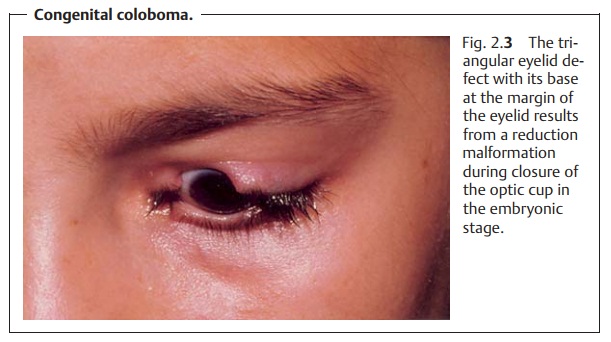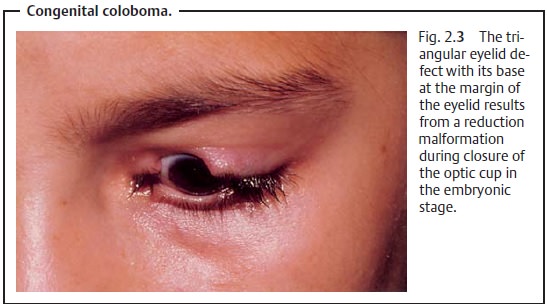Chapter: Ophthalmology: The Eyelids
Eyelids: Developmental Anomalies

Developmental Anomalies
Coloboma
Definition
A normally unilateral triangular eyelid defect
with its base at the margin of the eyelid occurring most often in the upper
eyelid (Fig. 2.3).

Epidemiology and etiology.Colobomas areraredefects
resulting from areduction malformation (defective closure of the optic cup).
They are only rarely the result of an injury.
Diagnostic considerations: The disorder is often accompanied by additionaldeformities such as dermoid cysts or a microphthalmos. Congenital defects of the first embryonic branchial arch that can result in coloboma include Franceschetti’s syndrome (mandibulofacial dysostosis) or Goldenhar’s syn-drome (oculoauriculovertebral dysplasia). Depending on the extent of the coloboma, desiccation symptoms on the conjunctiva and cornea with incipient ulceration may arise from the lack of regular and uniform moisten-ing of the conjunctiva and cornea.
Treatment: Defects are closed by direct approximation or plastic
surgerywith a skin flap.
Epicanthal Folds
A crescentic fold of skin usually extending
bilaterally between the upper and lower eyelids and covering the medial angle
of the eye. This rare congenitalanomaly is harmless and typical in eastern Asians.
However, it also occurswith Down’s syndrome (trisomy 21 syndrome). Thirty per
cent of newborns have epicanthal folds until the age of six months. Where one
fold is more pro-nounced, it can simulate esotropia. The nasal bridge becomes
more pro-nounced as the child grows, and most epicanthal folds disappear by the
age of four.
Blepharophimosis
This refers to shortening of the
horizontal palpebral fissure without patho-logic changes in the eyelids. The palpebral fissure, normally 28 – 30
mmwide, may be reduced to half that width. Blepharophimosis is a rare disorder that is either congenital or acquired (for example, from scar contracture or aging). As long as
the center of the pupil remains unobstructed despite the decreased size of the
palpebral fissure, surgical enlargement
of the palpebral fissure (by canthotomy or plastic surgery) has a purely
cosmetic purpose.
Ankyloblepharon
This refers to horizontal shortening of
the palpebral fissure with fusion ofthe eyelids at the lateral and medial
angles of the eye. Usually, the partial ortotal fusion between the upper and lower
eyelids will be bilateral, and the palpebral fissure will be partially or
completely occluded as a result. Posterior to the eyelids, the eyeball itself
will be deformed or totally absent. Ankylo-blepharon is frequently associated
with other skull deformities.
Related Topics